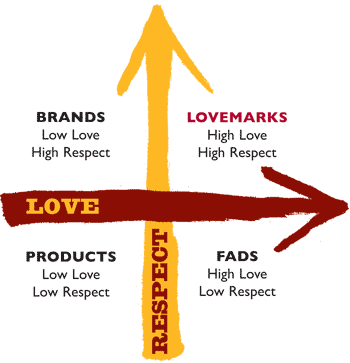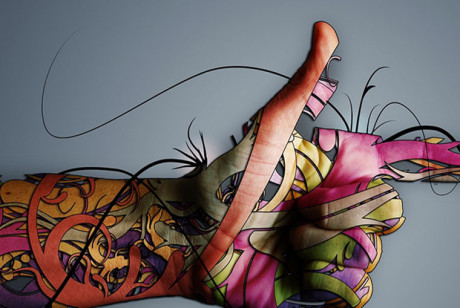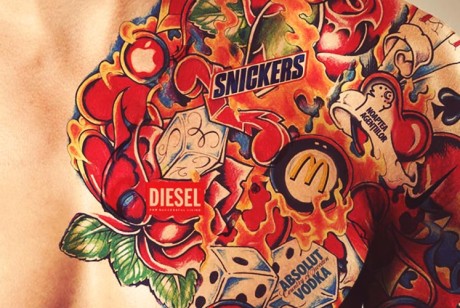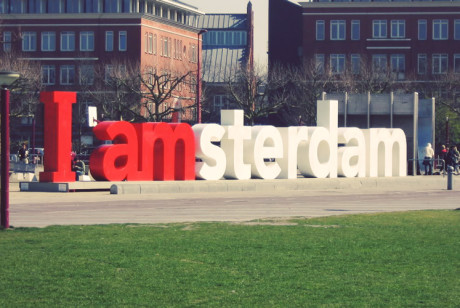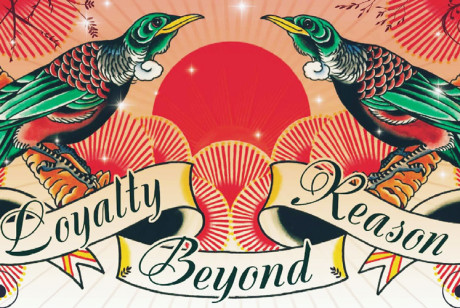Digital or Dinosaur
Thursday, 13 August 1998 - New York, USA

Presentation Summary
An address to the Jupiter Online Advertising Forum in New York. Great advertising should build outstanding connections between consumers and brands. This gloves-off presentation to a savvy Silicon Valley / Alley audience confronts both the “cooler than cool” attitude of the start-ups and the “you ain’t a billion-dollar business yet” attitude of the establishment.
Thank you for your invitation to speak today. I appear to be the sacrificial lamb, the middle of the road, the voice of traditional mainstream advertising, the has-been who’s being left behind by the leading edge new age hot shots.
If you are looking for a traditional advertising agency boss to beat up on, you’ve got the wrong guy. In fact, I don’t know much about advertising. I don’t know much about agencies. I’ve been with an agency for only 15 months and I’ve spent that time trying to change most of the things I found here.
I have, however, spent over thirty years in global marketing for great companies like Procter & Gamble and Pepsi. I have been the client for most of my career. And today I’m totally tuned into how we can make connections with consumers.
The first thing I did at Saatchi & Saatchi when I arrived was drop the word “advertising ” from the company name. Why? Because advertising is just a tool. Because my passion is for ideas not ads. I absolutely believe that Saatchi & Saatchi is in the ideas business. Great ideas about connecting brands with consumers, creating preference and loyalty. And I don’t give a damn what medium we use to make the connection.
This is the only business you can be in if your mission is to survive and thrive in the Attention Economy.
You all know the argument. People today are time-poor and stressed-out. They have increasing demands on their attention. There is just so much stuff out there, that attention has become a powerful currency. Information is a commodity, available to everyone and providing no real competitive advantage. What seizes attention is ideas. In today’s world, the idea is everything. We’re not living in the information age, or the Age of Knowledge. We’re smack in the middle of the Age of the Idea!
A passion for ideas, for big picture, out-of-the-box thinking is not just my personal driver. It is at the heart of Saatchi & Saatchi’s vision “to be revered as the hothouse for world-changing creative ideas.” This is the vision we want to be judged by. There’s nothing in it about advertising at all; but there’s everything about changing the world through ideas. Through our people, who believe that nothing is impossible.
It’s widely asserted that so-called mainstream agencies like Saatchi & Saatchi will find it impossible to grapple with the online world. That we’re going to become the dinosaurs of digital marketing. Too big, not hip enough, full of the digital homeless.
Let me make a statement as the Chief Executive of Saatchi & Saatchi. We are in fact, Godzilla, and we want it all: TV, print, billboards, infomercials, radio, pencils, skywriting, the web. If it’s right for an idea, we’ll use it.
To use Ricky Wurman’s term, we operate in “the age of also”. No new medium displaces an existing one, it simply adds to the choice of communication tools a marketer has available to make connections with consumers.
As for Saatchi & Saatchi’s view of the Internet, we are all still in the R&D phase – and beware of anyone who tells you any different. Net connections are growing exponentially, and so is the information mountain. Email is the quiet killer app, but how do you make a dime? Profit models are still far from clear.
Electronic commerce is emerging and there is no doubt this will be where the real revolution in the supply chain occurs. The seamless transaction is the thing. And still, most clients have only a basic commitment to the Internet. Their investments are actually pretty small and reflect a wait-and-see attitude.
My belief is that you have to have a lot of options and investments, and we all have to accept, and in fact revel in, making acts of faith.
We have our digital cards fully on the table. We wholly own Darwin Digital operating principally out of New York and San Francisco. Darwin has annual capitalized billings of over $40 million and a place in the top 20 interactive agencies in the USA. We have a large interactive group inside the Los Angeles office, Saatchi & Saatchi Vision in London plus web teams in offices from Singapore to Wellington, from Athens to Buenos Aires.
We have web projects for a stellar list of our roster clients including Procter & Gamble, Toyota, Lexus, Hewlett Packard and General Mills. And we are forming significant strategic alliances. One month ago we signed a partnership with LA Live who are a pioneer of streaming live broadcasts on the web.
And we have clients such as Time Warner, C-Net, Qualcomm (who own Eudora), General Magic, and a number of telcos throughout the world, who have us work on their communication strategies for convergence products and services.
And we’ve got http://www.saatchi.com, our site for the Innovation in Communication Award. We’ve run a worldwide ideas competition and in a few weeks we’re going to announce to the world the eleven hot, radical and world-changing ideas about communication that we’ve shortlisted. They’ll blow your mind.
We’ve got digital smarts all right, and just to make sure I puncture the chauvinistic bubble about being digital, advertising agencies have been hip to digital editing, graphics, video, music, effects, you name it, since the year dot. To me, the web is a no-brainer.
A brilliant concept realised through acutely elegant engineering. And it’s a pure and open market.
I think our teams are doing great work on the web, with relationship building, with real time, with Shockwave and Java.
And like all Chief Executives should, I have my own web sitehttp://saatchikevin.com.
If you think about it carefully, international networks like Saatchi & Saatchi have been labeled as dinosaurs by the hot shops for tactical and competitive reasons. And of course these are natural positions to take, the “cooler than cool” attitude of the start-ups versus the “you ain’t a billion dollar business yet” attitude of the establishment.
As far as Saatchi & Saatchi is concerned, we want to be big and fast. We have 162 offices in 92 countries and billings of more than US$7 billion.
But it’s a fallacy that to be sharp and nimble, you have to work in a loft somewhere deep in Silicon Alley.
What matters is the specific value we bring our clients, and I want to talk about two critical contributions we make: our ability to communicate consistent messages across all media, and our ability to inspire and captivate consumers with the unexpected and the extraordinary.
Our Toyota site http://www.toyota.com is a great example of why there is so much talk about the need for consistency and integration in a fragmenting market. The site comes out of our Los Angeles office where the digital creative strategy is integrated with everything else we are doing for the brand – television, magazines, brochures.
And this level of integration certainly doesn’t compromise the digital creative. We’re really proud that last month Toyota’s site was judged number one out of 40 automotive web sites by the independent research firm Automotive Marketing Consultants Inc.
I’m a big believer in what integration can achieve for a brand. I’m also a fan of what the inspired and the extraordinary, can do for consumers, no matter what the medium. Let me tell you about this idea, from Saatchi & Saatchi’s New York office. The Delta Air Lines “living billboard” has been an overwhelming success, generating more than 75 million audience impressions and meaningful employment. Not only did we create traffic jams in Times Square, but the billboard was reproduced and discussed in media all around the world. The financial value of the media coverage has been valued at close to $2 million, not counting the string of awards we have won.
You know, I really don’t care about technology at all. As we say on our Saatchi & Saatchi Innovation Award site: “An idea can be hi-tech, low-tech or no-tech”. And all my years of experience as a marketer tell me that most consumers don’t care about it either.
So what do we care about? What will the ideas I’m looking for do for consumers and for our clients?
I care about connections. I want Saatchi & Saatchi to build connections with consumers and I want those connections to be with their hearts, their guts and their minds, in that order. I welcome any idea, any idea at all, that will help us forge these connections.
A great brand reaches out with a powerful experience; it is an emotional connection point. Let’s check out the intensity of that connection in two interpretations of pretty much the same drive: gaming.
Here an email solicitation to take part in Liberty Loot. Customers are being offered a straightforward way to entertain themselves and to take a chance. The email invites you to enter a gaming site. Really compelling and engaging huh? It’s not from Saatchi & Saatchi.
I believe that there are two fundamental ways we can make connections with consumers. They can love us, or they can respect us.
This is my Love/Respect Axis, which enables me to instantly identify winners and losers. Consumers may well respect Liberty Loot if it offers them a good value experience, but really, it’s going nowhere. The surfer is quite a different proposition. He speaks to the human spirit, to the world of our dreams and aspirations. He is something people love.
The distinction between love and respect really matters. Love and respect are different poles in a continuum. I’m not interested in straightforward polarities, in opposites. It’s a no-brainer to set up love against hate, for instance, but what do you get out of it? I am fascinated by an axis across states which are both positive, but very different. Love resides in the heart; respect in the head.
Saatchi & Saatchi is all about love. My challenge is always this: will this communication lead consumers to love our clients’ brands more? Ideas, great ideas, do their work in the heart and in the gut. Once you have that, as the saying goes, their minds will follow.
You can draw some interesting implications from my Axis about the character and capabilities of different media. I have heard lengthy debates about this, and it won’t come as any surprise to you that I put today’s online media very firmly toward the respect end of the axis.
Sure I’m interested in targeting. Yes, tell me about customisation. Of course I want instant updating. Intelligent agents? Please introduce us. Design, as hot as possible please. What I really want is engagement. I want to engage dreams, memories, passion and laughter. That’s what great brands do. That’s what I want my people fixed on. And that’s what Saatchi & Saatchi will bring to the web and to any medium, any tool we touch.
I’m looking for ideas which accelerate past sharp banners and cool functionality. They’re just table stakes. We all have to be able to come up with them just to be players in this business. Time and time again I hear that some new level of interactivity which will turn the web from an information-rich, emotion-cool environment into one which can engage people in the way I know the “Endless Wave” does.
At the core of most visions of interactivity is one-to-one communication. This is seen as in opposition to mainstream advertising which is calculated as one-to-many. While I welcome the opportunity to reduce that equation, we shouldn’t shut ourselves off from another great one-to-many medium which still has a lot to teach us. This is the most emotionally powerful medium of the twentieth century: the movies.
For evidence of the global power of emotions and ideas, think about the phenomenal success of James Cameron’s Titanic. Without personalisation, without customisation, without interaction of any kind – and with an outcome known in advance, Cameron swept away the largest movie audience of all time. And this in the cynical and media savvy nineties.
How did he do it? By going straight for the love end of my Love/Respect axis with great storytelling.
To me this is where brands and brand building must also steer. For the emotional connections, for the great stories and for love.
Television has been another of the big ideas of the millennium, and I’m not going to argue six reasons for the elimination of television today.
All I want to say about television is this. Regular television broadcasts began in Britain on the BBC 1929. Ten years later when Britain declared war on Germany, television was turned off and wasn’t turned back on for seven years. And being British, it picked up exactly where it left off – in the middle of the cartoon “Mickey’s Birthday Party”. The same announcer introduced the cartoon with classic understatement: “Now, as I was saying when I was so rudely interrupted. . .”
Nathan Myhrvold of Microsoft had a very useful thing to say about the value of looking back, not just forward: “Every day, I have to make difficult decisions, and I base them primarily on what has happened in the past. History can lead you to see important abstractions, and it also offers great lessons in the need to avoid wild and tempting speculations about the future.”
Wild and tempting speculations about the future. I have certainly heard a lot of those. Every week or so revised projections and columns of numbers about growth flood my mailbox. When I test them on my Love/Respect axis, I’m relieved that most of them drop to the level of speculation so I can get on with the job.
That’s why I am relaxed about how to steer a large organisation like mine through this technology turmoil. This is just the beginning. The web is only 1500 days old, pretty young for a big idea to fully flower. At this stage we don’t have to respond to every eddy and swirl. In fact we could tip over if we do.
When I look at the stock prices of some online companies I instinctively cross check them against earnings and that really is the stuff of turmoil. The volatility of most Net stocks alarms me as a CEO committed to substantiating Saatchi & Saatchi’s stock price with real earnings, you know, that quaintly traditional stuff called profit. Of course brands have a measurable and significant value, but, New York magazine asked in their piece about brilliant young brands that almost always tank, can Yahoo really support a price-to-earnings ratio of 1,300? Is Amazon dot com really worth two Barnes and Nobles, asked the New York Times a month ago?
The online media have in general adopted advertising – the stuff that makes content possible – as the foundation of their business model. The rules have not yet been sorted, and with the acceleration of change we are seeing today, they may never be clear again. One observation I will toss into the hopper is that online advertising seems to me to be very internalised. So much of it is for other web-based products. It would be like TV advertising being dominated by TV sets, lazy-boy chairs, TV Guide and take-out pizza. This is going to have to change.
I cheered aloud recently when I saw Donald Norman from our client Hewlett-Packard say that “the personal computer is fundamentally too complicated.” I love the guys who invented the PC, but as they’ll also tell you, the PC is a clumsy device that sits on our desks and doesn’t know who you are.
PCs aren’t the future, the current interfaces are really clunky. Everyone here has to think ahead of the current appliance game when they’re considering the future of the Net.
I’m excited by the possibilities of distributed or embedded computing which makes consumer appliances smarter, and software which is transparent, intuitive and conversational.
What if I could not only experience the Toyota community on the net, but could also experience it in my vehicle? Online navigation systems, instant Zagat guides, onboard passenger entertainment…
To me, the “what ifs” are the challenge. At the frontline of advertising we must keep probing and asking difficult questions of each other. We must not be satisfied with routine answers. We must never have a united front, an agreed position.
I value the contentious, the awkward, the plainly provocative as well as the inspired and the extraordinary.
When everyone starts nodding their heads in agreement, especially about the future, I know I’m in trouble.
